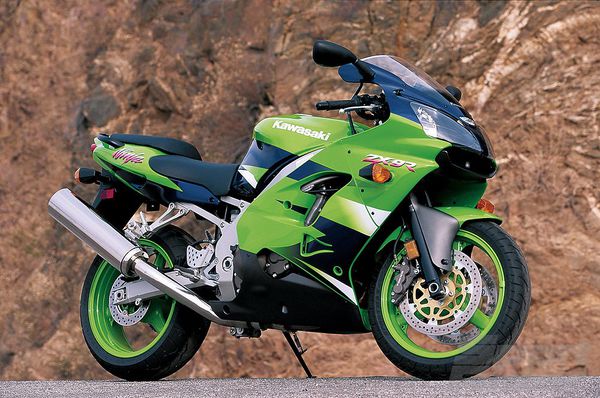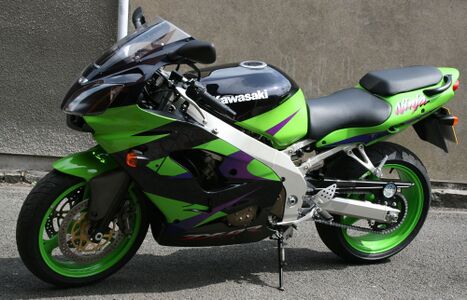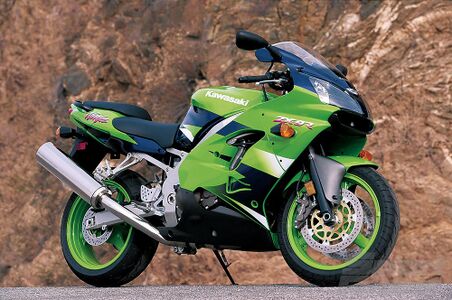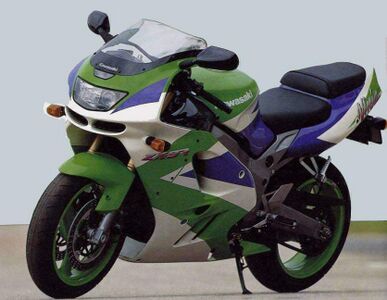Difference between revisions of "Kawasaki ZX-9R"
m |
m |
||
| (5 intermediate revisions by the same user not shown) | |||
| Line 1: | Line 1: | ||
| − | {{DISPLAYTITLE:Kawasaki ZX-9R Ninja}} | + | {{DISPLAYTITLE: Kawasaki ZX-9R Ninja}} |
| − | |||
{{#seo: | {{#seo: | ||
| − | |keywords= | + | |keywords={{PAGENAME}}, review, specs, owners manual, service manual, guide |
| + | |og:image=https://en.enduro.team/images/c/c1/Kawasaki-zx-9r-static-1.jpg | ||
}} | }} | ||
__notoc__ | __notoc__ | ||
| − | [[file:Kawasaki-zx-9r-static-1.jpg| | + | [[file: Kawasaki-zx-9r-static-1.jpg | 600px | center | Kawasaki ZX-9R (ZX900B) 1994-1997]] |
| − | + | ''' Kawasaki ZX-9R ''' sports bike model appeared in 1994 as Kawasaki's response to the [[Honda_CBR900RR_Fireblade | Honda CBR900RR Fireblade]] model, which almost immediately gained popularity in the market. With the CBR900RR Fireblade, Honda has been able to combine the power of a liter bike with the handling of lighter 750cc models. Kawasaki, on the other hand, offered more power and more impressive dynamic characteristics, but noticeably lost in weight and handling. In general, the ZX9R was more suited to the role of a sports tourist with its more upright fit and high clip-on position. | |
{{Ads_top}} | {{Ads_top}} | ||
| − | |||
| − | + | ''' Lineup: ''' | |
| + | * [[Kawasaki_ZX-6R | Kawasaki ZX-6R]] | ||
| + | * [[Kawasaki_ZX-7R | Kawasaki ZX-7R]] | ||
| + | * [[Kawasaki_ZX-9R | Kawasaki ZX-9R]] | ||
| + | * [[Kawasaki_ZX-10R | Kawasaki ZX-10R]] | ||
| + | * [[Kawasaki_ZX-12R | Kawasaki ZX-12R]] | ||
| − | + | ''' Main competitors ''' | |
| + | * [[Honda_CBR900RR_Fireblade | Honda CBR900RR Fireblade]] | ||
| + | * [[Suzuki_RF900 | Suzuki RF900]] | ||
| + | * [[Yamaha_YZF1000R_Thunderace | Yamaha YZF1000R Thunder Ace]] | ||
| − | + | The first versions of the Kawasaki Ninja ZX-9R were built on the basis of another sports model [[Kawasaki_ZXR750 | Kawasaki ZXR750]], getting from it virtually the same engine, but increased displacement and front inverted forks. Subsequent generations were significantly revised and finally separated from [[Kawasaki_ZXR750 | Kawasaki ZXR750]] - they received a new engine, frame and suspension. | |
| − | + | The Kawasaki ZX-9R was based on an in-line 4-cylinder liquid-cooled engine with a volume of 899 cm³, producing from 139 hp. on the first generations up to 144 hp. power on the latter. Engine performance could vary significantly depending on the countries of sale. | |
| − | + | Other features include an aluminum frame, fully adjustable sports suspensions, powerful brakes, a 6-speed gearbox, a 19 liter fuel tank (20 liters for the first generation) and 207 kg of curb weight (243 kg for the first generation). | |
| − | + | The first modifications of the Kawasaki ZX-9R had the factory designation '' ZX900B '' and featured a double headlight, an inverted fork, a 20-liter fuel tank, an aluminum tubular frame and 139 hp. | |
| − | + | In 1998, the model receives a restyling and a new factory designation '''ZX900C'''. This generation features a new frame, engine, suspensions (conventional 46 mm telescopic forks), 6-piston front calipers (appeared in the middle of the first generation) and smaller brake discs (296 mm instead of 320 mm). Maximum power - 143 hp | |
| − | + | In 2000, the model undergoes another update, changing the appearance (double headlight), rear suspension settings, increasing the dimension of the rear tire, getting new carburetors and increasing the maximum power to 144 hp. | |
| − | |||
| − | |||
| − | |||
| − | == | + | 2002 marked the last restyling of the model, which resulted in the ZX9R receiving 4-piston front calipers and 320mm discs, bringing back the previous 1st and 2nd generation carburetors and slightly increasing the curb weight. |
| − | + | ||
| − | + | 2003 was the last year of production of the model, after which it finally left the market, giving way to a completely new flagship model - [[Kawasaki_ZX-10R | Kawasaki ZX-10R]]. | |
| − | + | ||
| − | + | == Photos == | |
| − | + | <gallery mode="packed" heights=200px> | |
| − | + | File:Kawasaki-zx-9r-100698-617.jpg| | |
| + | File:Kawasaki-zx-9r-static-1.jpg| | ||
| + | File:Zx-9r 1994 2.jpg| | ||
| + | </gallery> | ||
{{Ads_feed}} | {{Ads_feed}} | ||
| − | |||
{{Ads_post}} | {{Ads_post}} | ||
| − | == | + | == Specifications == |
| − | + | Specifications Kawasaki ZX-9R Ninja: | |
| − | {| class="wikitable" | + | {| class = "wikitable" |
| − | ! scope="row"| | + | ! scope = "row" | Model |
| − | |Kawasaki ZX-9R | + | | Kawasaki ZX-9R |
|- | |- | ||
| − | ! scope="row"| | + | ! scope = "row" | Motorcycle type |
| − | | | + | | sports |
|- | |- | ||
| − | ! scope="row"| | + | ! scope = "row" | Release year |
| − | |1994-2003 | + | | 1994-2003 |
|- | |- | ||
| − | ! scope="row"| | + | ! scope = "row" | Frame |
| − | | | + | | aluminum tubular - ZX900B |
| − | + | aluminum cast - ZX900C, ZX900E, ZX900F | |
|- | |- | ||
| − | ! scope="row"| | + | ! scope = "row" | Engine type |
| − | |4- | + | | 4-cylinder, 4-stroke, in-line |
|- | |- | ||
| − | ! scope="row"| | + | ! scope = "row" | Working volume |
| − | |899 | + | | 899 cm³ |
|- | |- | ||
| − | ! scope="row"| | + | ! scope = "row" | Bore / Stroke |
| − | |73 | + | | 73.0 x 53.7mm - ZX900B |
| − | 75 | + | 75.0 x 50.9 mm - ZX900C, ZX900E, ZX900F |
|- | |- | ||
| − | ! scope="row"| | + | ! scope = "row" | Compression ratio |
| − | |11.5:1 | + | | 11.5: 1 - ZX900B, ZX900C |
| − | 12.2:1 - ZX900E, ZX900F | + | 12.2: 1 - ZX900E, ZX900F |
|- | |- | ||
| − | ! scope="row"| | + | ! scope = "row" | Cooling |
| − | | | + | | liquid |
|- | |- | ||
| − | ! scope="row"| | + | ! scope = "row" | Number of valves per cylinder |
| − | |DOHC, 4 | + | | DOHC, 4 valves per cylinder |
|- | |- | ||
| − | ! scope="row"| | + | ! scope = "row" | Fuel supply system |
| − | | | + | | Carburetor, 4x Keihin CVKD40 - ZX900B, ZX900C, ZX900F |
| − | + | Carburetor, 4x Keihin CVRD40 - ZX900E | |
|- | |- | ||
| − | ! scope="row"| | + | ! scope = "row" | Ignition type |
| − | | | + | | transistor |
|- | |- | ||
| − | ! scope="row"| | + | ! scope = "row" | Maximum power |
| − | |139 | + | | 139.0 h.p. (102.0 kW) @ 10,500 rpm - ZX900B (full version) |
| − | 143 | + | 143.0 h.p. (105.0 kW) @ 11000 rpm - ZX900C (full version) |
| − | 144 | + | 144.0 h.p. (106.0 kW) @ 11000 rpm - ZX900E, ZX900F (full-strength versions) |
|- | |- | ||
| − | ! scope="row"| | + | ! scope = "row" | Maximum torque |
| − | |96 | + | | 96.0 Nm (9.8 kg * m) @ 9000 rpm - ZX900B (full-strength versions) |
| − | 101 | + | 101.0 Nm (10.3 kg * m) @ 9000 rpm - ZX900C (full strength versions) |
| − | 101 | + | 101.0 Nm (10.3 kg * m) @ 9200 rpm - ZX900E, ZX900F (full-strength versions) |
|- | |- | ||
| − | ! scope="row"| | + | ! scope = "row" | Gearbox |
| − | |6- | + | | 6-speed |
|- | |- | ||
| − | ! scope="row"| | + | ! scope = "row" | Drive type |
| − | | | + | | chain |
|- | |- | ||
| − | ! scope="row"| | + | ! scope = "row" | Front tire size |
| − | |120/70 ZR17 (58W) | + | | 120/70 ZR17 (58W) |
|- | |- | ||
| − | ! scope="row"| | + | ! scope = "row" | Rear tire size |
| − | |180/55 ZR17 (73W) | + | | 180/55 ZR17 (73W) - ZX900B, ZX900C |
| − | 190/50 ZR17 (73W) | + | 190/50 ZR17 (73W) - ZX900E, ZX900F |
|- | |- | ||
| − | ! scope="row"| | + | ! scope = "row" | Front brakes |
| − | |2 | + | | 2 discs, 320mm, 4-piston calipers - ZX900B1-B2 |
| − | 2 | + | 2 discs, 320mm, 6-piston calipers - ZX900B3-B4 |
| − | 2 | + | 2 discs, 296mm, 6-piston calipers - ZX900C, ZX900E |
| − | 2 | + | 2 discs, 320mm, 4-piston calipers - ZX900F |
|- | |- | ||
| − | ! scope="row"| | + | ! scope = "row" | Rear brakes |
| − | |1 | + | | 1 disc, 220 mm, 1-piston caliper |
|- | |- | ||
| − | ! scope="row"| | + | ! scope = "row" | Front suspension |
| − | | | + | | 43mm Inverted Fork (Fully Adjustable), 110mm Travel - ZX900B |
| − | + | 46mm Telescopic Fork (Fully Adjustable), 120mm Travel - ZX900C, ZX900E, ZX900F | |
|- | |- | ||
| − | ! scope="row"| | + | ! scope = "row" | Rear suspension |
| − | | | + | | linkage Uni-Trak with monoshock (adjustable), stroke - 145 mm - ZX900B |
| − | + | linkage Uni-Trak with monoshock (adjustable), stroke - 130 mm - ZX900C | |
| − | + | linkage Uni-Trak with monoshock (adjustable), stroke - 135 mm - ZX900E, ZX900F | |
|- | |- | ||
| − | ! scope="row"| | + | ! scope = "row" | Motorcycle length |
| − | |2085 | + | | 2085 mm - ZX900B |
| − | 2050 | + | 2050 mm - ZX900C, ZX900E |
| − | 2065 | + | 2065 mm - ZX900F |
|- | |- | ||
| − | ! scope="row"| | + | ! scope = "row" | Motorcycle width |
| − | |725 | + | | 725 mm - ZX900B |
| − | 720 | + | 720 mm - ZX900C |
| − | 730 | + | 730 mm - ZX900E, ZX900F |
|- | |- | ||
| − | ! scope="row"| | + | ! scope = "row" | Motorcycle height |
| − | |1165 | + | | 1165 mm - ZX900B |
| − | 1155 | + | 1155 mm - ZX900C, ZX900E, ZX900F |
|- | |- | ||
| − | ! scope="row"| | + | ! scope = "row" | Wheelbase |
| − | |1440 | + | | 1440 mm - ZX900B |
| − | 1415 | + | 1415 mm - ZX900C, ZX900E, ZX900F |
|- | |- | ||
| − | ! scope="row"| | + | ! scope = "row" | Saddle height |
| − | |800 | + | | 800 mm - ZX900B |
| − | 810 | + | 810 mm - ZX900C |
| − | 815 | + | 815 mm - ZX900E, ZX900F |
|- | |- | ||
| − | ! scope="row"| | + | ! scope = "row" | Minimum ground clearance |
| − | |125 | + | | 125 mm - ZX900B |
| − | + | 160mm - ZX900C, ZX900E, ZX900F | |
|- | |- | ||
| − | ! scope="row"| | + | ! scope = "row" | Acceleration to 100 km / h |
| − | |3 | + | | 3.02 sec. |
|- | |- | ||
| − | ! scope="row"| | + | ! scope = "row" | Maximum speed |
| − | |273 | + | | 273 km / h |
|- | |- | ||
| − | ! scope="row"| | + | ! scope = "row" | Fuel tank capacity |
| − | |20 | + | | 20.0 L - ZX900B |
| − | 19 | + | 19.0 L - ZX900C, ZX900E, ZX900F |
|- | |- | ||
| − | ! scope="row"| | + | ! scope = "row" | Motorcycle weight (dry) |
| − | |215 | + | | 215 kg - ZX900B |
| − | 183 | + | 183 kg - ZX900C, ZX900E |
| − | 186 | + | 186 kg - ZX900F |
|- | |- | ||
| − | ! scope="row"| | + | ! scope = "row" | Motorcycle weight (curb) |
| − | |243 | + | | 243 kg - ZX900B |
| − | 207 | + | 207 kg - ZX900C, ZX900E |
| − | 212 | + | 212 kg - ZX900F |
|- | |- | ||
|} | |} | ||
| − | == | + | == Documentation == |
| − | + | [[Category:Motorcycles]] | |
| − | + | * [[Kawasaki_ZX-9R:_manuals|Kawasaki ZX-9R]] | |
| − | |||
| − | |||
| − | |||
| − | |||
| − | |||
| − | |||
| − | |||
| − | |||
| − | |||
| − | |||
| − | * [[Kawasaki_ZX-9R:_manuals|Kawasaki ZX-9R | ||
== == | == == | ||
{{Ads_recomended}} | {{Ads_recomended}} | ||
Latest revision as of 21:08, 19 July 2023
Kawasaki ZX-9R sports bike model appeared in 1994 as Kawasaki's response to the Honda CBR900RR Fireblade model, which almost immediately gained popularity in the market. With the CBR900RR Fireblade, Honda has been able to combine the power of a liter bike with the handling of lighter 750cc models. Kawasaki, on the other hand, offered more power and more impressive dynamic characteristics, but noticeably lost in weight and handling. In general, the ZX9R was more suited to the role of a sports tourist with its more upright fit and high clip-on position.
Lineup:
Main competitors
The first versions of the Kawasaki Ninja ZX-9R were built on the basis of another sports model Kawasaki ZXR750, getting from it virtually the same engine, but increased displacement and front inverted forks. Subsequent generations were significantly revised and finally separated from Kawasaki ZXR750 - they received a new engine, frame and suspension.
The Kawasaki ZX-9R was based on an in-line 4-cylinder liquid-cooled engine with a volume of 899 cm³, producing from 139 hp. on the first generations up to 144 hp. power on the latter. Engine performance could vary significantly depending on the countries of sale.
Other features include an aluminum frame, fully adjustable sports suspensions, powerful brakes, a 6-speed gearbox, a 19 liter fuel tank (20 liters for the first generation) and 207 kg of curb weight (243 kg for the first generation).
The first modifications of the Kawasaki ZX-9R had the factory designation ZX900B and featured a double headlight, an inverted fork, a 20-liter fuel tank, an aluminum tubular frame and 139 hp.
In 1998, the model receives a restyling and a new factory designation ZX900C. This generation features a new frame, engine, suspensions (conventional 46 mm telescopic forks), 6-piston front calipers (appeared in the middle of the first generation) and smaller brake discs (296 mm instead of 320 mm). Maximum power - 143 hp
In 2000, the model undergoes another update, changing the appearance (double headlight), rear suspension settings, increasing the dimension of the rear tire, getting new carburetors and increasing the maximum power to 144 hp.
2002 marked the last restyling of the model, which resulted in the ZX9R receiving 4-piston front calipers and 320mm discs, bringing back the previous 1st and 2nd generation carburetors and slightly increasing the curb weight.
2003 was the last year of production of the model, after which it finally left the market, giving way to a completely new flagship model - Kawasaki ZX-10R.
Photos
Specifications
Specifications Kawasaki ZX-9R Ninja:
| Model | Kawasaki ZX-9R |
|---|---|
| Motorcycle type | sports |
| Release year | 1994-2003 |
| Frame | aluminum tubular - ZX900B
aluminum cast - ZX900C, ZX900E, ZX900F |
| Engine type | 4-cylinder, 4-stroke, in-line |
| Working volume | 899 cm³ |
| Bore / Stroke | 73.0 x 53.7mm - ZX900B
75.0 x 50.9 mm - ZX900C, ZX900E, ZX900F |
| Compression ratio | 11.5: 1 - ZX900B, ZX900C
12.2: 1 - ZX900E, ZX900F |
| Cooling | liquid |
| Number of valves per cylinder | DOHC, 4 valves per cylinder |
| Fuel supply system | Carburetor, 4x Keihin CVKD40 - ZX900B, ZX900C, ZX900F
Carburetor, 4x Keihin CVRD40 - ZX900E |
| Ignition type | transistor |
| Maximum power | 139.0 h.p. (102.0 kW) @ 10,500 rpm - ZX900B (full version)
143.0 h.p. (105.0 kW) @ 11000 rpm - ZX900C (full version) 144.0 h.p. (106.0 kW) @ 11000 rpm - ZX900E, ZX900F (full-strength versions) |
| Maximum torque | 96.0 Nm (9.8 kg * m) @ 9000 rpm - ZX900B (full-strength versions)
101.0 Nm (10.3 kg * m) @ 9000 rpm - ZX900C (full strength versions) 101.0 Nm (10.3 kg * m) @ 9200 rpm - ZX900E, ZX900F (full-strength versions) |
| Gearbox | 6-speed |
| Drive type | chain |
| Front tire size | 120/70 ZR17 (58W) |
| Rear tire size | 180/55 ZR17 (73W) - ZX900B, ZX900C
190/50 ZR17 (73W) - ZX900E, ZX900F |
| Front brakes | 2 discs, 320mm, 4-piston calipers - ZX900B1-B2
2 discs, 320mm, 6-piston calipers - ZX900B3-B4 2 discs, 296mm, 6-piston calipers - ZX900C, ZX900E 2 discs, 320mm, 4-piston calipers - ZX900F |
| Rear brakes | 1 disc, 220 mm, 1-piston caliper |
| Front suspension | 43mm Inverted Fork (Fully Adjustable), 110mm Travel - ZX900B
46mm Telescopic Fork (Fully Adjustable), 120mm Travel - ZX900C, ZX900E, ZX900F |
| Rear suspension | linkage Uni-Trak with monoshock (adjustable), stroke - 145 mm - ZX900B
linkage Uni-Trak with monoshock (adjustable), stroke - 130 mm - ZX900C linkage Uni-Trak with monoshock (adjustable), stroke - 135 mm - ZX900E, ZX900F |
| Motorcycle length | 2085 mm - ZX900B
2050 mm - ZX900C, ZX900E 2065 mm - ZX900F |
| Motorcycle width | 725 mm - ZX900B
720 mm - ZX900C 730 mm - ZX900E, ZX900F |
| Motorcycle height | 1165 mm - ZX900B
1155 mm - ZX900C, ZX900E, ZX900F |
| Wheelbase | 1440 mm - ZX900B
1415 mm - ZX900C, ZX900E, ZX900F |
| Saddle height | 800 mm - ZX900B
810 mm - ZX900C 815 mm - ZX900E, ZX900F |
| Minimum ground clearance | 125 mm - ZX900B
160mm - ZX900C, ZX900E, ZX900F |
| Acceleration to 100 km / h | 3.02 sec. |
| Maximum speed | 273 km / h |
| Fuel tank capacity | 20.0 L - ZX900B
19.0 L - ZX900C, ZX900E, ZX900F |
| Motorcycle weight (dry) | 215 kg - ZX900B
183 kg - ZX900C, ZX900E 186 kg - ZX900F |
| Motorcycle weight (curb) | 243 kg - ZX900B
207 kg - ZX900C, ZX900E 212 kg - ZX900F |
Documentation



